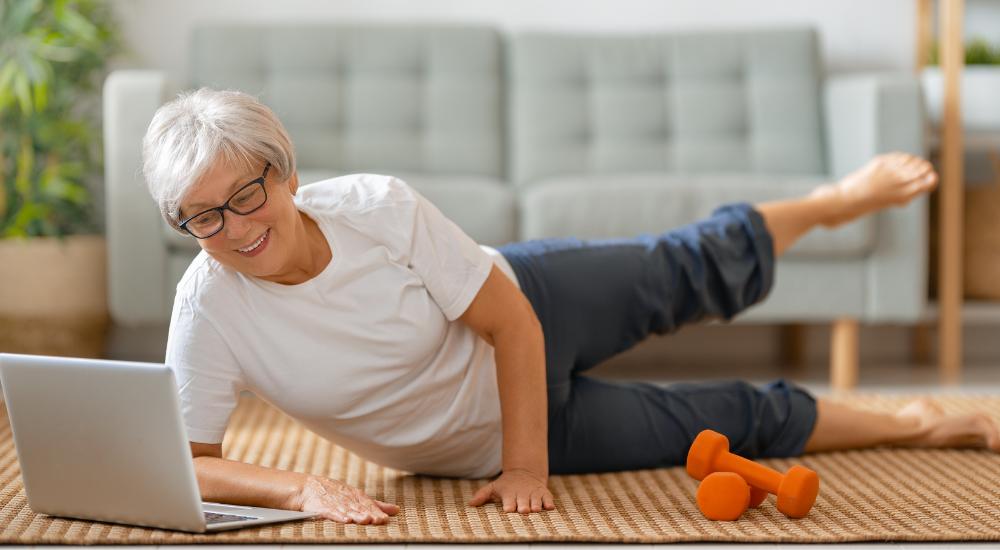As we age, the importance of balance becomes even more crucial. Maintaining good balance not only helps prevent falls, but it also plays a significant role in our overall health. In this article, we will explore the connection between balance and aging, the science behind exercise and stability, and provide a comprehensive guide to balance exercises for seniors that can be done at home. By incorporating these exercises into your daily routine, you can improve stability and prevent falls.
Key Takeaways
- Balance is Critical for Seniors: As people age, maintaining balance becomes increasingly important for everyday activities and overall health. The decline in muscle strength, sensory perception, and quickness of reaction can increase the risk of falls, making balance exercises essential for seniors.
- Comprehensive Guide to Balance Exercises: The article provides a variety of balance exercises that can be easily performed at home. These include standing on one leg, walking heel-to-toe, practicing yoga, and other activities aimed at improving flexibility, stability, and coordination. Regular engagement in these exercises can significantly enhance a senior's balance and reduce their fall risk.
- Benefits Extend Beyond Fall Prevention: Incorporating balance exercises into a daily routine not only helps in preventing falls but also contributes to overall health and well-being. Improved balance is linked with better posture, reduced risk of chronic pain, and positive impacts on mental health. The article emphasizes the holistic advantages of balance exercises, including enhanced quality of life and independence for seniors.
Understanding the Importance of Balance for Seniors
As we get older, our balance tends to decline naturally. This is due to several factors, including changes in muscle strength, sensory perception, and the body's ability to react quickly to sudden movements. Good balance is essential for everyday activities such as walking, getting up from a chair, or reaching for something on a shelf. Seniors with poor balance are at a higher risk of falling, which can lead to severe injuries.
It's crucial for seniors to incorporate balance exercises into their daily routine to help improve and maintain their balance. These exercises can include standing on one leg, walking heel-to-toe in a straight line, or practicing yoga to enhance flexibility and stability. By engaging in regular balance training, seniors can strengthen their muscles, improve coordination, and reduce the risk of falls.

The Connection Between Age and Balance
Age-related changes in the body can affect our balance. The proprioceptive system, which helps us maintain our body position, becomes less efficient as we age. Additionally, our vision and inner ear function may also decline, impacting our sense of balance. Aging also affects muscle strength and flexibility, making it more challenging to maintain stability.
Furthermore, certain medical conditions such as arthritis, Parkinson's disease, or stroke can also contribute to balance problems in seniors. These conditions can affect mobility, coordination, and muscle control, further increasing the risk of falls. It's essential for seniors to work closely with healthcare providers to address any underlying health issues that may be impacting their balance.
How Balance Affects Overall Health
Good balance is not only important for preventing falls, but it also has a significant impact on our overall health and well-being. When we have good balance, we can move more confidently and perform daily activities with ease. It also helps maintain proper posture and reduces the risk of developing muscle imbalances and chronic pain. By improving our balance, we can enhance our quality of life and maintain independence.
In addition to physical benefits, good balance can also have positive effects on mental health. Studies have shown that regular physical activity, including balance exercises, can help reduce stress, anxiety, and depression in seniors. By staying active and maintaining good balance, seniors can improve their mood, cognitive function, and overall well-being.
The Role of Exercise in Enhancing Stability
Exercise is a powerful tool for improving stability and preventing falls. It helps strengthen muscles, improves coordination, and enhances proprioception. Regular exercise also contributes to better bone density, which can reduce the risk of fractures in case of a fall. By incorporating specific balance exercises into your routine, you can significantly enhance your stability.
Furthermore, engaging in regular physical activity not only benefits your physical health but also has positive effects on mental well-being. Exercise releases endorphins, also known as "feel-good" hormones, which can help reduce stress and anxiety levels. This dual benefit of exercise on both physical and mental health underscores its importance in enhancing overall stability and quality of life.

The Science Behind Exercise and Stability
When we engage in physical activity, our body adapts and becomes more efficient in maintaining balance. Exercise helps strengthen the muscles, particularly those in the legs and core, which are crucial for maintaining stability. It also stimulates the proprioceptive system, improving our body's ability to sense and react to changes in position.
Moreover, exercise plays a vital role in improving cardiovascular health, which is essential for overall well-being. A strong cardiovascular system ensures that oxygen and nutrients are efficiently delivered to the muscles, including those responsible for balance and stability. This interconnected relationship between exercise, stability, and cardiovascular health highlights the holistic benefits of incorporating physical activity into your daily routine.
Different Types of Exercises for Stability
There are various types of exercises that can help improve stability. Some examples include standing on one leg, heel-to-toe walking, and practicing Tai Chi or Yoga. These exercises focus on strengthening the core, improving flexibility, and challenging the balance systems in the body. It's essential to choose exercises that suit your fitness level and abilities.
Read more: Top 10 Aerobic Activities for Seniors to Stay Active and Healthy
Additionally, incorporating resistance training into your exercise regimen can further enhance stability by building muscle strength and endurance. Resistance exercises, such as squats, lunges, and planks, target multiple muscle groups simultaneously, promoting overall stability and functional movement patterns. By incorporating a diverse range of exercises that target different aspects of physical fitness, you can create a well-rounded stability-enhancing workout routine.
Comprehensive Guide to Balance Exercises for Seniors
Before starting any exercise program, it's important to prioritize safety. Begin with a warm-up to loosen up your muscles and increase blood flow. Consider seeking guidance from a healthcare professional or a certified fitness instructor who specializes in senior fitness. They can provide tailored exercises that suit your needs and help prevent injury.
Safety Precautions Before Starting Balance Exercises
When doing balance exercises, always make sure you have a stable surface nearby to hold onto in case you feel unsteady. Wear comfortable shoes with good traction to avoid slipping. Start with simple exercises and gradually increase the difficulty level. If you experience any pain or dizziness, stop and consult a healthcare professional.

Step-by-Step Guide to Balance Exercises
Here is a step-by-step guide to some effective balance exercises for seniors:
- Stand with your feet shoulder-width apart and slowly lift one foot off the ground, balancing on the other foot. Hold for a few seconds, then switch legs. Repeat 10 times on each leg.
- Place one foot in front of the other, touching heel-to-toe. Take small steps forward for 20 steps, then walk backward using the same technique.
- Stand near a stable surface and practice sitting down and standing up from a chair without using your hands. Repeat 10 times.
- Try balancing on one leg while brushing your teeth or doing simple household tasks. Gradually increase the duration as you become more comfortable.
Balance exercises not only improve stability but also help in preventing falls, which can be a common concern for seniors. By incorporating these exercises into your routine, you can enhance your overall quality of life and maintain independence.
In addition to the exercises mentioned above, yoga and tai chi are also great options for seniors looking to improve balance. These practices focus on body awareness, flexibility, and core strength, all of which contribute to better balance. Joining a local yoga or tai chi class specifically designed for seniors can provide a supportive environment and expert guidance.
Another important aspect of balance exercises is incorporating strength training. Building muscle strength in the legs and core can significantly improve balance and stability. Consider adding exercises such as squats, lunges, and leg lifts to your routine. Start with lighter weights or no weights at all, and gradually increase the resistance as you progress.
Remember, consistency is key when it comes to balance exercises. Aim for at least three sessions per week, and gradually increase the duration and intensity as you feel more comfortable. It's important to listen to your body and make adjustments as needed.
Preventing Falls Through Balance Exercises
By consistently practicing balance exercises, you can significantly reduce the risk of falls. Regular exercise improves muscle strength, enhances coordination, and increases confidence in movement. The more you challenge your balance, the more adaptable and resilient your body becomes.

The Correlation Between Balance Exercises and Fall Prevention
Research has shown a strong correlation between balance exercises and fall prevention in seniors. A study published in the Journal of the American Geriatrics Society found that exercises targeting balance significantly reduced the risk of falls by nearly 40%. When combined with other fall prevention strategies such as home modifications and regular vision check-ups, the risk can be further reduced.
Long-Term Benefits of Regular Balance Exercises
Engaging in regular balance exercises can yield long-term benefits for seniors. Not only can it improve stability and reduce the risk of falls, but it can also enhance overall physical function and quality of life. The increased muscle strength and improved coordination gained through these exercises can help seniors maintain independence and continue to participate in activities they enjoy.
Maintaining Consistency and Progress in Balance Exercises
Consistency is key when it comes to balance exercises. Aim to incorporate these exercises into your daily routine, even if it's just for a few minutes each day. As you progress, don't be afraid to challenge yourself. Gradually increase the difficulty level of the exercises or try new variations to keep your body engaged.

Setting Realistic Goals for Balance Improvement
When starting your balance exercise journey, it's important to set realistic goals. Focus on improving a little bit each day rather than aiming for instant perfection. Celebrate small achievements along the way to stay motivated and track your progress.
Tracking Progress and Adjusting Exercise Routines
Keep a record of your exercises and track your progress over time. This will help you see how far you've come and can be a great source of motivation. If certain exercises become too easy, don't hesitate to increase the challenge. Add variations or incorporate props like balance boards or stability balls to keep your routine interesting and continue challenging your balance.
Remember, improving stability and preventing falls is a journey that requires commitment and consistency. By incorporating these balance exercises into your daily routine, you can enhance your stability, reduce the risk of falls, and enjoy a healthier, more active lifestyle well into your senior years.
FAQs
Why is balance training important for seniors?
Balance training is crucial for seniors because it helps prevent falls by improving stability and coordination. As we age, our balance naturally declines, making it important to incorporate exercises that maintain and enhance balance, thereby reducing the risk of injuries associated with falls.
Can balance exercises improve overall health in seniors?
Yes, balance exercises can significantly improve overall health in seniors. Beyond preventing falls, these exercises contribute to better muscle strength, flexibility, and joint mobility. They also support cardiovascular health and can have positive effects on mental health by reducing stress and anxiety levels.
How often should seniors perform balance exercises?
Seniors should aim to incorporate balance exercises into their daily routine. Starting with a few minutes each day and gradually increasing the duration and intensity based on comfort and ability is recommended. Consistency is key to seeing improvements in balance and stability.
Are there any specific balance exercises recommended for seniors with limited mobility?
For seniors with limited mobility, simple seated or supported exercises can be beneficial. Exercises like seated leg lifts, toe taps, and chair stands can improve strength and balance even with mobility constraints. Always consult with a healthcare provider before starting a new exercise regimen, especially if mobility is limited or if there are health concerns.




